A High-Resolution (20 m) Simulation of Nighttime Low Temperature Inducing Agricultural Crop Damage with the WRF–LES Modeling System
Abstract
:1. Introduction
2. Study Area and Methodology
2.1. Topographical Characteristics of Study Area
2.2. Weather Observation Data
2.3. Climatological Analysis
2.4. Frost Damage Cases
2.5. WRF–LES Model Setup
2.5.1. Domain Configuration and Physical Scheme Specification
2.5.2. Performance Measures for Model Evaluation
3. Result and Discussion
3.1. Case 1 (4–5 April 2020)
3.2. Case 2 (9–10 April 2020)
4. Summary and Concluding Remarks
Author Contributions
Funding
Acknowledgments
Conflicts of Interest
References
- Hatfield, J.L.; Prueger, J.H. Temperature extremes: Effect on plant growth and development. Weather Clim. Extrem. 2015, 10, 4–10. [Google Scholar] [CrossRef] [Green Version]
- Proebsting, E.L.; Mills, H.H. Low-temperature resistance of developing flower buds of 6 deciduous fruit species. J. Am. Soc. Hortic. Sci. 1978, 103, 192–198. [Google Scholar]
- Rodrigo, J. Spring frosts in deciduous fruit trees—Morphological damage and flower hardiness. Sci. Hortic. 2000, 85, 155–173. [Google Scholar] [CrossRef]
- Snyder, R.; Paw, U.K.; Thompson, J. Passive Frost Protection of Trees and Vines; University of California: Los Angeles, CA, USA, 1987; Available online: https://anrcatalog.ucanr.edu/pdf/21429e.pdf (accessed on 19 November 2021).
- Snyder, R.L.; Melo-Abreu, J.D. Frost Protection: Fundamentals, Practice and Economics; FAO: Rome, Italy, 2005; Volume 1, pp. 1–240. [Google Scholar]
- Lindkvist, L.; Gustavsson, T.; Bogren, J. A frost assessment method for mountainous areas. Agric. For. Meteorol. 2000, 102, 51–67. [Google Scholar] [CrossRef]
- Mahrt, L.; Sun, J.L.; Oncley, S.P.; Horst, T.W. Transient Cold Air Drainage down a Shallow Valley. J. Atmos. Sci. 2014, 71, 2534–2544. [Google Scholar] [CrossRef]
- Chung, U.; Seo, H.H.; Hwang, K.H.; Hwang, B.S.; Choi, J.; Lee, J.T.; Yun, J.I. Minimum temperature mapping over complex terrain by estimating cold air accumulation potential. Agric. For. Meteorol. 2006, 137, 15–24. [Google Scholar] [CrossRef]
- Holden, Z.A.; Abatzoglou, J.T.; Luce, C.H.; Baggett, L.S. Empirical downscaling of daily minimum air temperature at very fine resolutions in complex terrain. Agric. For. Meteorol. 2011, 151, 1066–1073. [Google Scholar] [CrossRef]
- Ashcroft, M.B.; Gollan, J.R. Fine-resolution (25 m) topoclimatic grids of near-surface (5 cm) extreme temperatures and humidities across various habitats in a large (200 × 300 km) and diverse region. Int. J. Climatol. 2012, 32, 2134–2148. [Google Scholar] [CrossRef] [Green Version]
- Gobbett, D.L.; Nidumolu, U.; Crimp, S. Modelling frost generates insights for managing risk of minimum temperature extremes. Weather Clim. Extrem. 2020, 27, 9. [Google Scholar] [CrossRef]
- Skamarock, W.C.; Klemp, J.B.; Dudhia, J.; Gill, D.O.; Liu, Z.; Berner, J.; Wang, W.; Powers, J.G.; Duda, M.G.; Barker, D.; et al. A Description of the Advanced Research WRF Model Version 4; National Center for Atmospheric Research: Boulder, CO, USA, 2019. [CrossRef]
- Moeng, C.H.; Dudhia, J.; Klemp, J.; Sullivan, P. Examining two-way grid nesting for large eddy simulation of the PBL using the WRF model. Mon. Weather Rev. 2007, 135, 2295–2311. [Google Scholar] [CrossRef]
- Moeng, C.H. A Large-eddy-simulation model for the study of planetary boundary-layer turbulence. J. Atmos. Sci. 1984, 41, 2052–2062. [Google Scholar] [CrossRef]
- Parodi, A.; Tanelli, S. Influence of turbulence parameterizations on high-resolution numerical modeling of tropical convection observed during the TC4 field campaign. J. Geophys. Res. Atmos. 2010, 115. [Google Scholar] [CrossRef]
- Gibbs, J.A.; Fedorovich, E. Comparison of Convective Boundary Layer Velocity Spectra Retrieved from Large-Eddy-Simulation and Weather Research and Forecasting Model Data. J. Appl. Meteorol. Climatol. 2014, 53, 377–394. [Google Scholar] [CrossRef]
- Munoz-Esparza, D.; Kosovic, B.; Garcia-Sanchez, C.; van Beeck, J. Nesting Turbulence in an Offshore Convective Boundary Layer Using Large-Eddy Simulations. Bound. Layer Meteorol. 2014, 151, 453–478. [Google Scholar] [CrossRef]
- Heath, N.K.; Fuelberg, H.E.; Tanelli, S.; Turk, F.J.; Lawson, R.P.; Woods, S.; Freeman, S. WRF nested large-eddy simulations of deep convection during SEAC(4)RS. J. Geophys. Res. Atmos. 2017, 122, 3953–3974. [Google Scholar] [CrossRef]
- Simon, J.S.; Zhou, B.W.; Mirocha, J.D.; Chow, F.K. Explicit Filtering and Reconstruction to Reduce Grid Dependence in Convective Boundary Layer Simulations Using WRF-LES. Mon. Weather Rev. 2019, 147, 1805–1821. [Google Scholar] [CrossRef]
- Zhong, J.; Nikolova, I.; Cai, X.; MacKenzie, A.R.; Alam, M.S.; Xu, R.; Singh, A.; Harrison, R.M. Traffic-induced multicomponent ultrafine particle microphysics in the WRF v3.6.1 large eddy simulation model: General behaviour from idealised scenarios at the neighbourhood-scale. Atmos. Environ. 2020, 223. [Google Scholar] [CrossRef]
- Cece, R.; Bernard, D.; Brioude, J.; Zahibo, N. Microscale anthropogenic pollution modelling in a small tropical island during weak trade winds: Lagrangian particle dispersion simulations using real nested LES meteorological fields. Atmos. Environ. 2016, 139, 98–112. [Google Scholar] [CrossRef]
- Liu, Y.J.; Liu, Y.B.; Munoz-Esparza, D.; Hu, F.; Yan, C.; Miao, S.G. Simulation of Flow Fields in Complex Terrain with WRF-LES: Sensitivity Assessment of Different PBL Treatments. J. Appl. Meteorol. Climatol. 2020, 59, 1481–1501. [Google Scholar] [CrossRef]
- Udina, M.; Montornes, A.; Casso, P.; Kosovic, B.; Bech, J. WRF-LES Simulation of the Boundary Layer Turbulent Processes during the BLLAST Campaign. Atmosphere 2020, 11, 1149. [Google Scholar] [CrossRef]
- Huang, Y.J.; Liu, Y.B.; Liu, Y.W.; Li, H.Y.; Knievel, J.C. Mechanisms for a Record-Breaking Rainfall in the Coastal Metropolitan City of Guangzhou, China: Observation Analysis and Nested Very Large Eddy Simulation With the WRF Model. J. Geophys. Res. Atmos. 2019, 124, 1370–1391. [Google Scholar] [CrossRef]
- Cui, C.X.; Bao, Y.X.; Yuan, C.S.; Li, Z.H.; Zong, C. Comparison of the performances between the WRF and WRF-LES models in radiation fog—A case study. Atmos. Res. 2019, 226, 76–86. [Google Scholar] [CrossRef]
- Talbot, C.; Bou-Zeid, E.; Smith, J. Nested Mesoscale Large-Eddy Simulations with WRF: Performance in Real Test Cases. J. Hydrometeorol. 2012, 13, 1421–1441. [Google Scholar] [CrossRef]
- Cuchiara, G.C.; Rappengluck, B. Performance analysis of WRF and LES in describing the evolution and structure of the planetary boundary layer. Environ. Fluid Mech. 2018, 18, 1257–1273. [Google Scholar] [CrossRef]
- Simon, J.S.; Bragg, A.D.; Dirmeyer, P.A.; Chaney, N.W. Semi-Coupling of a Field-Scale Resolving Land-Surface Model and WRF-LES to Investigate the Influence of Land-Surface Heterogeneity on Cloud Development. J. Adv. Model. Earth Syst. 2021, 13, 24. [Google Scholar] [CrossRef]
- Zhu, P. A multiple scale modeling system for coastal hurricane wind damage mitigation. Nat. Hazards 2008, 47, 577–591. [Google Scholar] [CrossRef]
- Zhu, P. Simulation and parameterization of the turbulent transport in the hurricane boundary layer by large eddies. J. Geophys. Res. Atmos. 2008, 113, 16. [Google Scholar] [CrossRef]
- Munoz-Esparza, D.; Lundquist, J.K.; Sauer, J.A.; Kosovic, B.; Linn, R.R. Coupled mesoscale-LES modeling of a diurnal cycle during the CWEX-13 field campaign: From weather to boundary-layer eddies. J. Adv. Model. Earth Syst. 2017, 9, 1572–1594. [Google Scholar] [CrossRef]
- Bauer, H.S.; Muppa, S.K.; Wulfmeyer, V.; Behrendt, A.; Warrach-Sagi, K.; Spath, F. Multi-nested WRF simulations for studying planetary boundary layer processes on the turbulence-permitting scale in a realistic mesoscale environment. Tellus Ser. A-Dyn. Meteorol. Oceanol. 2020, 72, 28. [Google Scholar] [CrossRef]
- Early Warning System for Agrometeorological Hazard. Available online: http://www.agmet.kr (accessed on 19 November 2021).
- Kim, J.-H.; Kim, D.-j.; Kim, S.-o.; Yun, E.-j.; Ju, O.; Park, J.S.; Shin, Y.S. Estimation of freeze damage risk according to developmental stage of fruit flower buds in spring. Korean J. Agric. For. Meteorol. 2019, 21, 55–64. [Google Scholar] [CrossRef]
- Lim, K.S.S.; Hong, S.Y. Development of an Effective Double-Moment Cloud Microphysics Scheme with Prognostic Cloud Condensation Nuclei (CCN) for Weather and Climate Models. Mon. Weather Rev. 2010, 138, 1587–1612. [Google Scholar] [CrossRef] [Green Version]
- Mlawer, E.J.; Taubman, S.J.; Brown, P.D.; Iacono, M.J.; Clough, S.A. Radiative transfer for inhomogeneous atmospheres: RRTM, a validated correlated-k model for the longwave. J. Geophys. Res. Atmos. 1997, 102, 16663–16682. [Google Scholar] [CrossRef] [Green Version]
- Dudhia, J. Numerical study of convection observed during the winter monsoon experiment using a mesoscale two-dimensional model. J. Atmos. Sci. 1989, 46, 3077–3107. [Google Scholar] [CrossRef]
- Monin, A.S.; Obukhov, A.M. Basic laws of turbulent mixing in the surface layer of the atmosphere. Contrib. Geophys. Inst. Acad. Sci. USSR 1954, 151, e187. [Google Scholar]
- Kain, J.S. The Kain-Fritsch convective parameterization: An update. J. Appl. Meteorol. 2004, 43, 170–181. [Google Scholar] [CrossRef] [Green Version]
- Shin, H.H.; Hong, S.Y. Representation of the Subgrid-Scale Turbulent Transport in Convective Boundary Layers at Gray-Zone Resolutions. Mon. Weather Rev. 2015, 143, 250–271. [Google Scholar] [CrossRef]
- Kovadlo, P.G.; Lukin, V.P.; Shikhovtsev, A.Y. Development of the Model of Turbulent Atmosphere at the Large Solar Vacuum Telescope Site as Applied to Image Adaptation. Atmos. Ocean. Opt. 2019, 32, 202–206. [Google Scholar] [CrossRef]
- Archer, C.L.; Wu, S.C.; Ma, Y.L.; Jimenez, P.A. Two Corrections for Turbulent Kinetic Energy Generated by Wind Farms in the WRF Model. Mon. Weather Rev. 2020, 148, 4823–4835. [Google Scholar] [CrossRef]
- Choi, S.-W.; Lee, S.-J.; Kim, J.; Lee, B.-L.; Kim, K.-R.; Choi, B.-C. Agrometeorological observation environment and periodic report of Korea Meteorological Administration: Current status and suggestions. Korean J. Agric. For. Meteorol. 2015, 17, 144–155. [Google Scholar] [CrossRef] [Green Version]
- Kim, D.J.; Kang, G.; Kim, D.; Kim, J.J. Characteristics of LDAPS-Predicted Surface Wind Speed and Temperature at Automated Weather Stations with Different Surrounding Land Cover and Topography in Korea. Atmosphere 2020, 11, 1224. [Google Scholar] [CrossRef]
- Lee, S.-J.; Song, J.; Kim, Y.-J. The NCAM Land-Atmosphere Modeling Package (LAMP) Version 1: Implementation and Evaluation. Korean J. Agric. For. Meteorol. 2016, 18. [Google Scholar] [CrossRef] [Green Version]



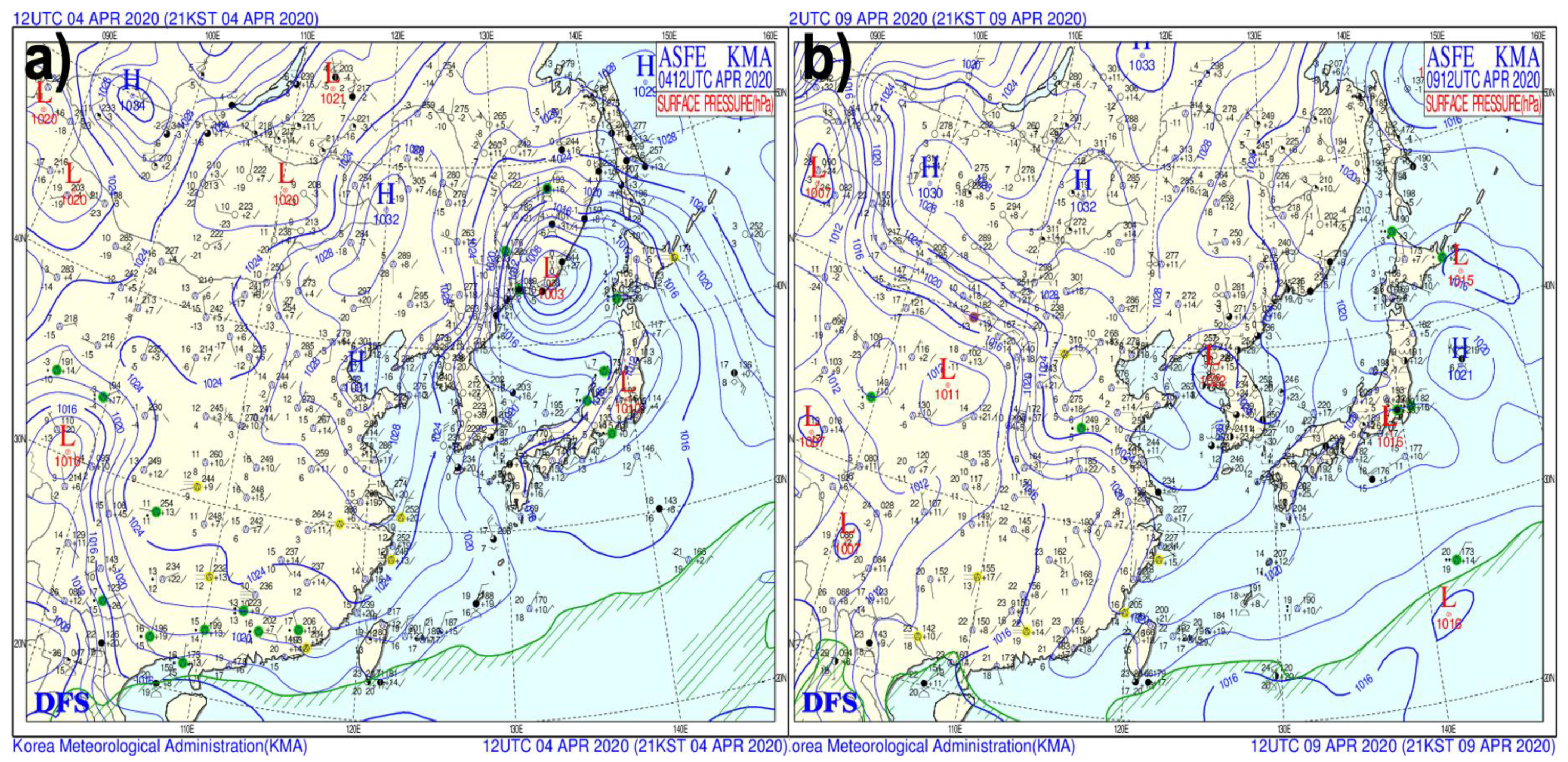
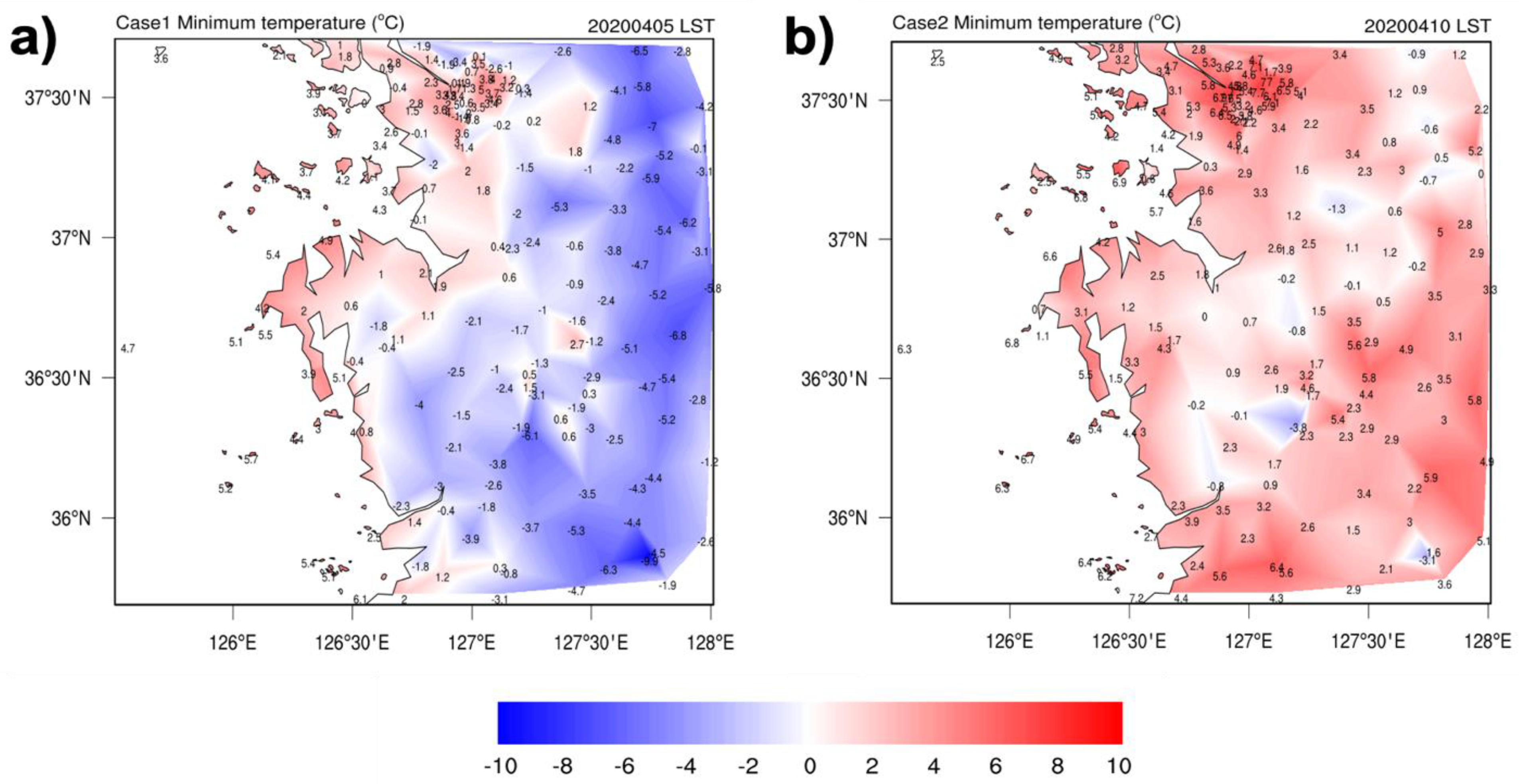
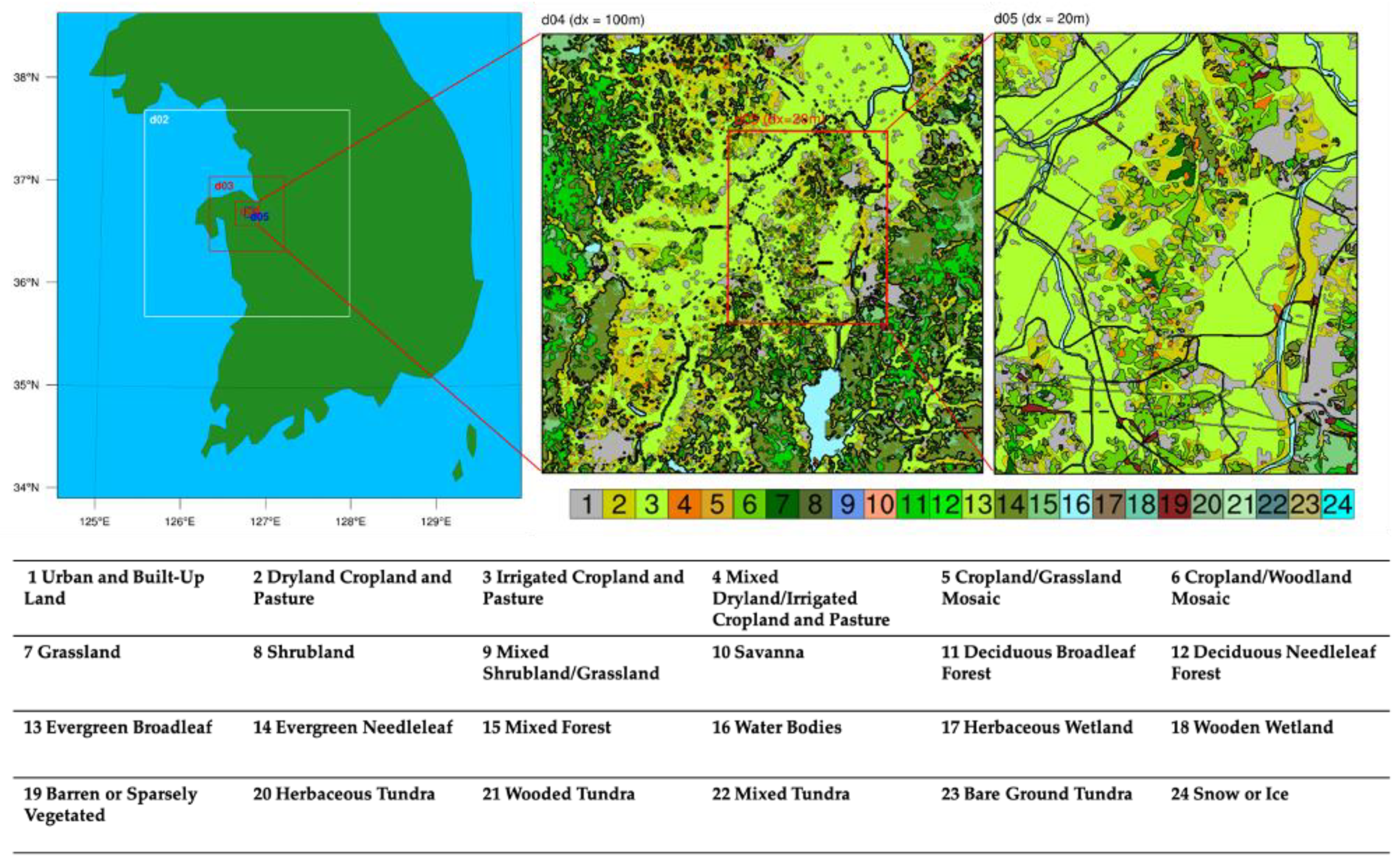
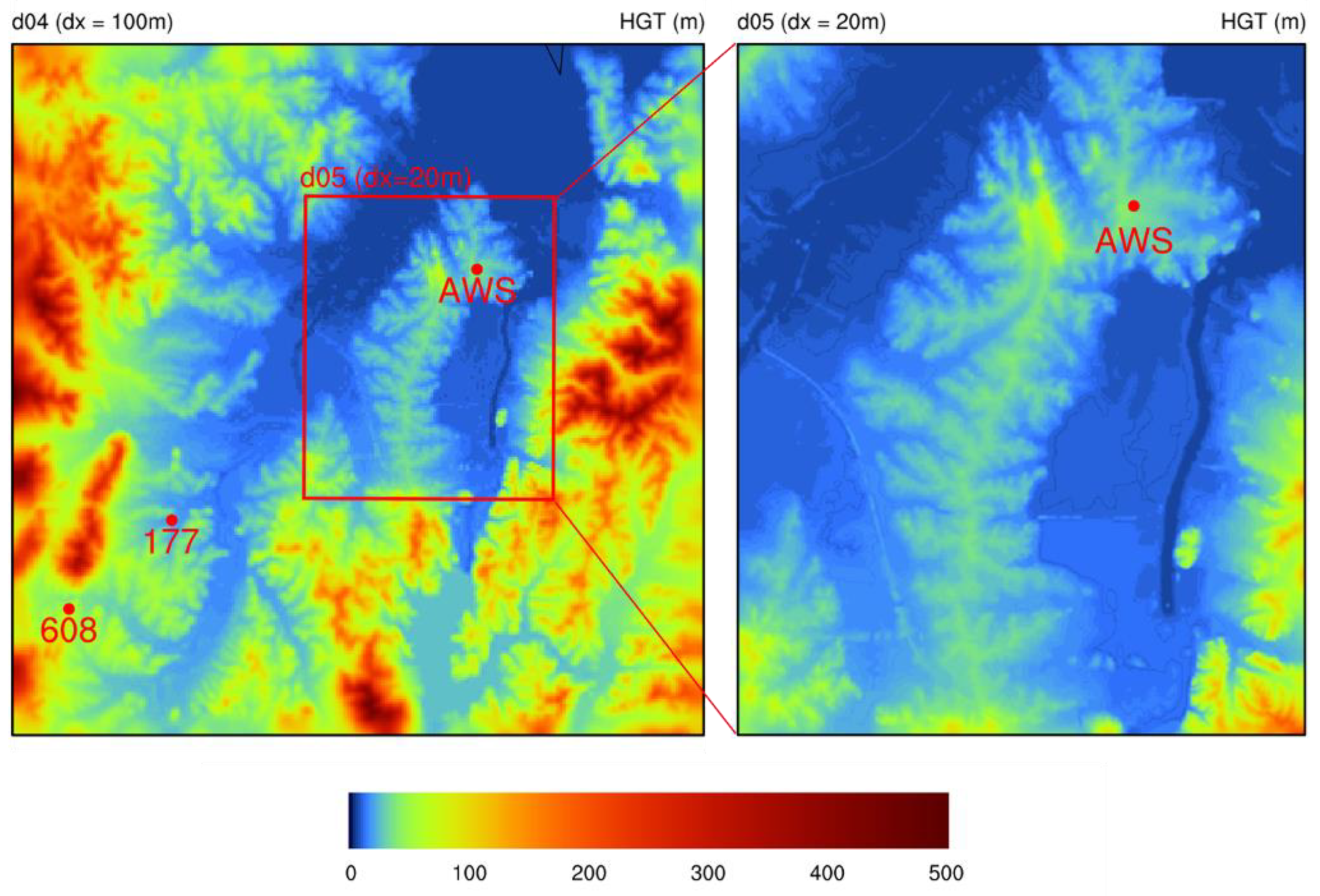

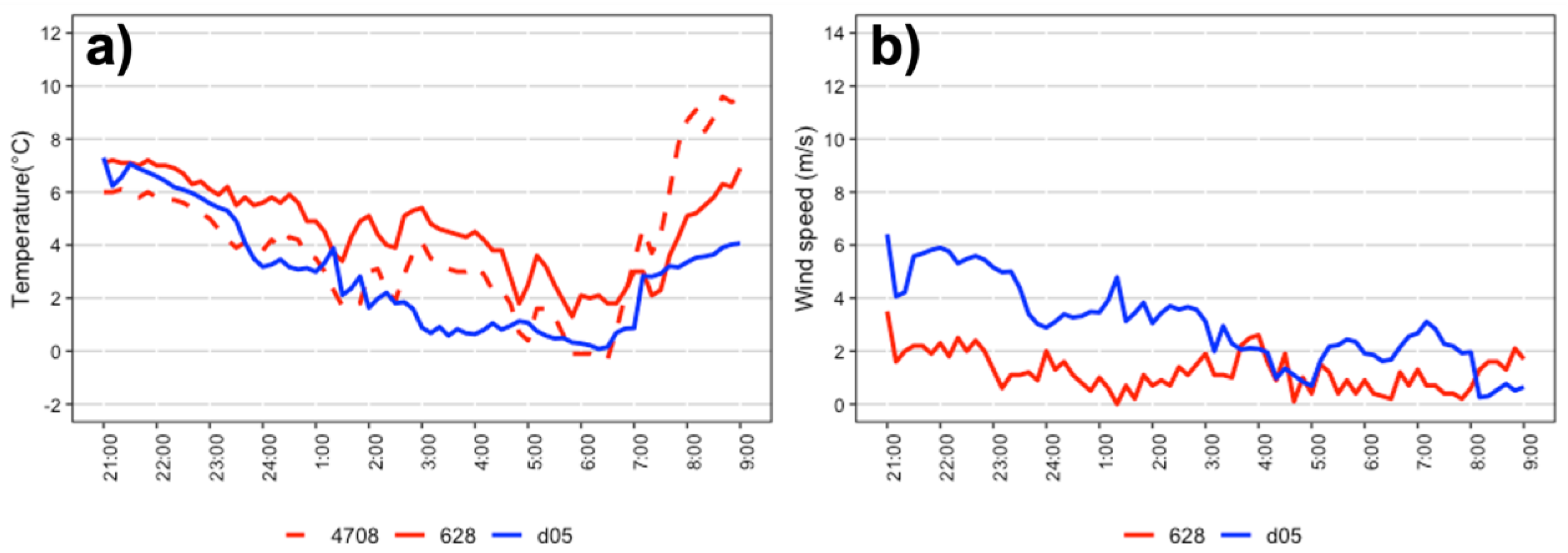
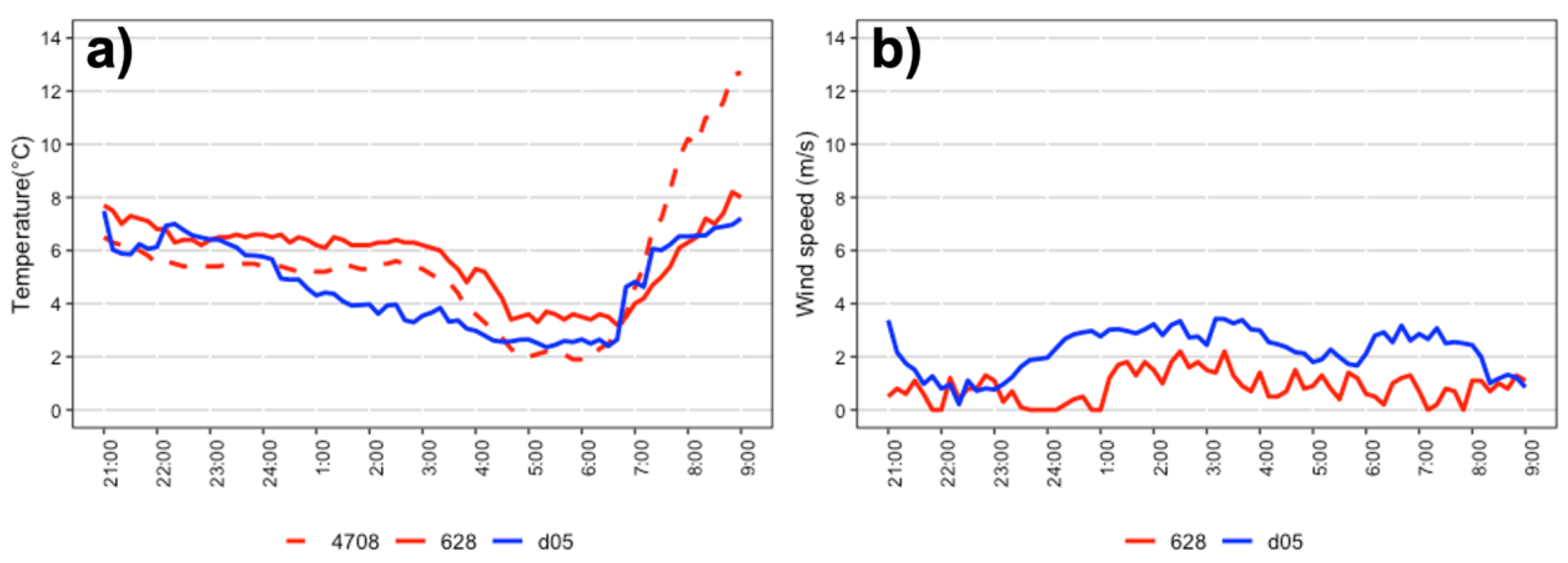
| Domain | PBL Scheme | dx, dy (m) | Grid Points | Time Step (s) |
|---|---|---|---|---|
| D01 | Shin–Hong PBL | 2700 | 187 × 196 × 81 | 15 |
| D02 | Shin–Hong PBL | 900 | 247 × 250 × 81 | 5 |
| D03 | Shin–Hong PBL | 300 | 271 × 271 × 81 | 5/3 |
| D04 | LES | 100 | 259 × 259 × 81 | 5/9 |
| D05 | LES | 20 | 461 × 561 × 81 | 5/54 |
| D01 | D02 | D03 | D04 | D05 | |
|---|---|---|---|---|---|
| Microphysics | WDM6 | ||||
| Longwave radiation | RRTM scheme | ||||
| Shortwave radiation | Dudhia scheme | ||||
| Cumulus | Kain–Fritsch scheme | Off | |||
| PBL | Shin–Hong scheme | Off | |||
| Diffusion | Simple diffusion | Full diffusion | |||
| K option | 2D deformation | 3D TKE | |||
| Surface layer | Monin–Obukhov scheme | ||||
| Domain | AWS Site Number | Variable | MB | RMSE |
|---|---|---|---|---|
| D04 | 177 | T2 | −0.50 | 1.33 |
| WS | −0.13 | 1.92 | ||
| 608 | T2 | 0.50 | 1.31 | |
| WS | −0.72 | 1.92 | ||
| 628 | T2 | 0.66 | 1.47 | |
| WS | 0.60 | 1.36 | ||
| 4708 | T2 | 1.43 | 4.48 | |
| D05 | 628 | T2 | −1.75 | 2.13 |
| WS | 1.78 | 2.31 | ||
| 4708 | T2 | −0.98 | 2.13 |
| Domain | AWS Site Number | Variable | MB | RMSE |
|---|---|---|---|---|
| D04 | 177 | T2 | −1.11 | 2.28 |
| WS | 4.55 | 24.76 | ||
| 608 | T2 | 0.26 | 1.41 | |
| WS | 4.52 | 25.69 | ||
| 628 | T2 | −2.30 | 6.90 | |
| WS | 2.22 | 7.37 | ||
| 4708 | T2 | −1.95 | 9.60 | |
| D05 | 628 | T2 | −1.02 | 2.22 |
| WS | 1.37 | 2.64 | ||
| 4708 | T2 | −0.68 | 3.00 |
Publisher’s Note: MDPI stays neutral with regard to jurisdictional claims in published maps and institutional affiliations. |
© 2021 by the authors. Licensee MDPI, Basel, Switzerland. This article is an open access article distributed under the terms and conditions of the Creative Commons Attribution (CC BY) license (https://creativecommons.org/licenses/by/4.0/).
Share and Cite
Noh, I.; Lee, S.-J.; Lee, S.; Kim, S.-J.; Yang, S.-D. A High-Resolution (20 m) Simulation of Nighttime Low Temperature Inducing Agricultural Crop Damage with the WRF–LES Modeling System. Atmosphere 2021, 12, 1562. https://doi.org/10.3390/atmos12121562
Noh I, Lee S-J, Lee S, Kim S-J, Yang S-D. A High-Resolution (20 m) Simulation of Nighttime Low Temperature Inducing Agricultural Crop Damage with the WRF–LES Modeling System. Atmosphere. 2021; 12(12):1562. https://doi.org/10.3390/atmos12121562
Chicago/Turabian StyleNoh, Ilseok, Seung-Jae Lee, Seoyeon Lee, Sun-Jae Kim, and Sung-Don Yang. 2021. "A High-Resolution (20 m) Simulation of Nighttime Low Temperature Inducing Agricultural Crop Damage with the WRF–LES Modeling System" Atmosphere 12, no. 12: 1562. https://doi.org/10.3390/atmos12121562
APA StyleNoh, I., Lee, S.-J., Lee, S., Kim, S.-J., & Yang, S.-D. (2021). A High-Resolution (20 m) Simulation of Nighttime Low Temperature Inducing Agricultural Crop Damage with the WRF–LES Modeling System. Atmosphere, 12(12), 1562. https://doi.org/10.3390/atmos12121562






